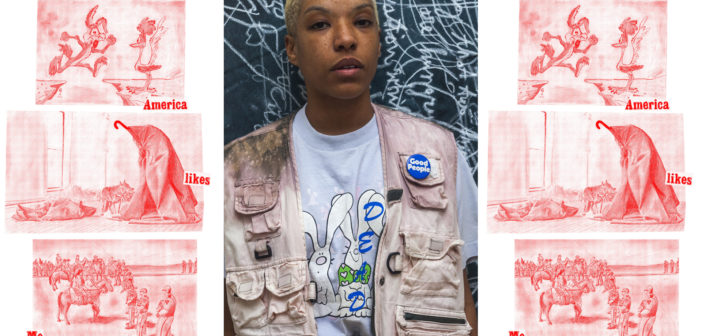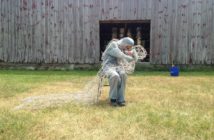Ian Solaski is a graduating senior at the Studio for Interrelated Media at MassArt. I was first exposed to his work as his professor. This encounter was intense; he was developing a performance in which he violently translated the Sandy Hook Elementary shooting that happened in 2013 in his hometown. In the performance, Solaski used his body to clear out a classroom full of chairs, charging and jumping towards the furniture in what seemed as a choreographed self-mutilation exercise that transcended the voyeuristic role of the spectator into a meditative reflexion on humanity, the self, and the other. His dedication to the piece was tremendous. He performed it several times for the faculty (sometimes hurting himself in the process), perfecting the movements and measuring his steps with the discipline of a professional dancer. Still, during my time as his professor, what has been more striking about Ian is his selflessness and his calculated efforts to distract from his own authorship through his ongoing project BLESHÜE.
BLESHÜE is a consumer brand / cultural agency that Ian has been using as a front for his creative outlet. In its best moments, the project calls to mind other artist-led operations that work under the guise of corporate structures in order to infiltrate mass media or to simply play with the dynamics of commercial enterprises. Maywa Denki, eToy, NSK, Mejor Vida Corp. and Nuevos Ricos are just some of the projects that seem to be right there with BLESHÜE in this family tree.
I talked to Ian about his influences and projects as he prepares for his new pop-up event BEUYANT that will open on May 12th at the Midway Artist Studios Gallery in Fort Point during this season’s Art Walk and Open Studios.
Juan Obando: Can you please tell me what BLESHÜE is, in general, and how it got started?
Ian Solaski: BLESHÜE is a brand which I created back in 2012 while I was in high school. It started out as a clothing company but has since transformed into more of a curatorial agency with an emphasis on how pedagogy presents itself within consumer culture, with projects ranging from podcasts to furniture.
JO: How did this transition happen? Was this shaped by your experience as an art student?
IS: Definitely. Prior to going to art school, I was much more invested in particular subcultures like skateboarding, hip-hop, graffiti and streetwear, and catered my projects to those associated with these cultures.
But as I was introduced to a deeper understanding of art history and art theory, I began to see how there is a clear correlation between all forms of consumable culture, as well as how information is passed through commodity. I began to see how products can be used as social instruments and tools for educational engagement.
JO: Totally. Back in Colombia in the 90s, we were definitely being educated, alternatively, by American consumer culture. Things like Thrasher Magazine and Dischord Records were not only sources of teenage aesthetic adoration but also tools to learn about new cultural forms, new ways of seeing the world, and languages to describe it.
IS: Exactly. I think it stems from the early influence that brands like Supreme had on me. They would release a shirt or a skateboard that had an image or reference that was totally foreign to me. I would then dig deeper and become amazed by what I was finding. I’d then feel the urge to own it, and if I did have the privilege of owning it, it was as if I was owning that reference, and then felt an obligation to use it as a wearable piece of information and share it with others.
JO: What is unique about BLESHÜE, though, is its awareness of its educational potential and the revisionists approach that it embraces. What was the first time that you made a clear point about this aspect with the brand? I remember one of your earlier projects was already hinting at some sort of compressed Art History collection…
IS: Probably my first attempt to at doing something similar was with a project called INLFÜENZA by BLESHÜE. I had assembled a collection of artists and thinkers that I felt had influences beyond their time and audience. I then put references of these individuals into objects like t-shirts and chairs, to show how their ideas and practices permeate the mainstream yet are silent, almost as a virus.
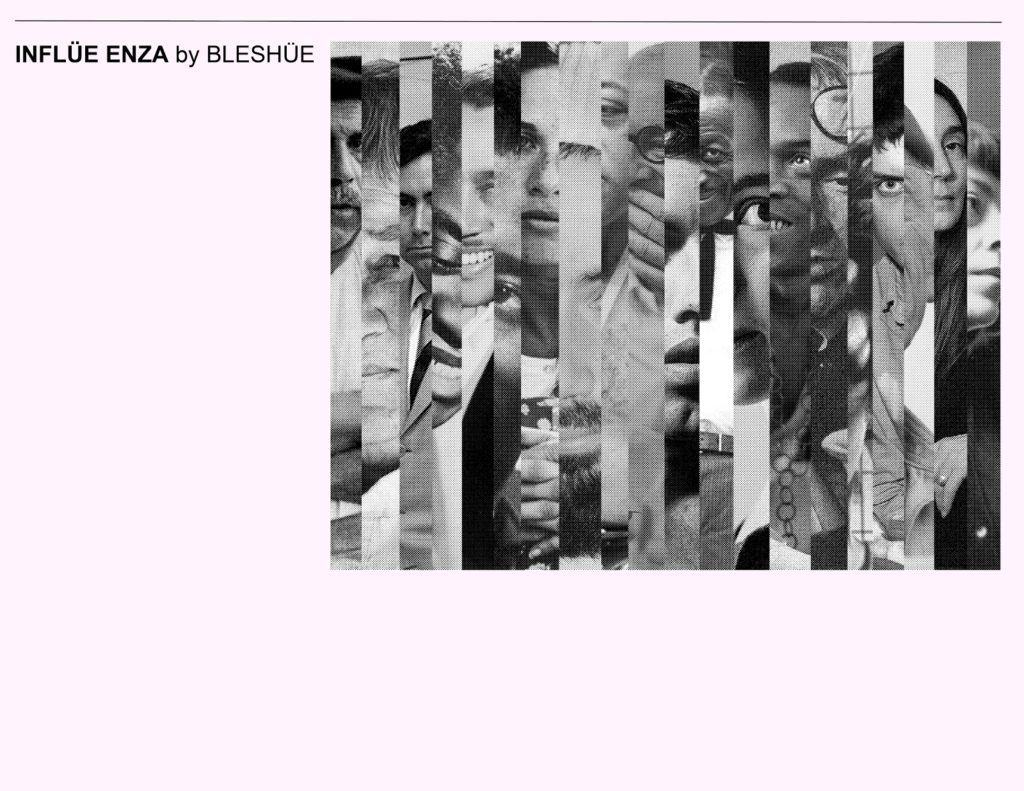
JO: Now, for this new collection, BLESHÜE is totally into Joseph Beuys. Why him? Why now?
IS: Joseph Beuys was actually one of the people I thought about for the INLFÜE ENZA project, and revisiting him in this moment was something I decided for a number of reasons.
From a personal standpoint, I'm very much invested in fashion, and for Beuys to be such an outspoken dresser, and to have clothing and material be so pertinent to him and his practice, his body of work lends itself to this sort of reinterpretation. And as I began to do further research on Beuys, I began to see more and more parallels between his practices and what's happening today in America. I wanted to present Joseph Beuys to an audience otherwise unfamiliar with his work in a way that was relatable, and so I created this trifecta of reference: American pop culture, Joseph Beuys/Social Sculpture, and the current sociopolitical climate in the United States.
JO: Could you please expand on how to you perceive these conditions in context? What do you mean when you say "parallels between his practices and what's happening today in America"?
IS: A lot of Beuys was trying to push was this idea that as a society we need to reassess our modes of communication, with emphasis on new "languages of healing.” This stems from his guilt for his implications in the Holocaust. Today in America, rhetoric that is eerily similar to that which was pushed during the time of World War II, is being thrown into the air haphazardly and is being normalized in mainstream structures. There appears now to be a divide, between those who choose to be submissive or passive, those who associate, and those who choose to dissociate. Given the tenuous nature of the conditions we are all facing, none of these options seem viable if we are to reach a new level of understanding and commitment to equity as a whole.
JO: I see. At first, I thought this revision of Beuys through consumer goods was a playful critique around the mythology of Beuys the character. But the more I saw you working on it, the more I realized that you were consciously studying his works, words, and methods from multiple and diverse sources, and somehow channeling his aura through the making of this project: You created your own handmade typography for the posters, you have collaborated with others in some pieces, and you even included some of his sculptural materials as part of your design library. Could you tell me a bit about what's happening in the space for this upcoming BLESHÜE pop-up exhibition?
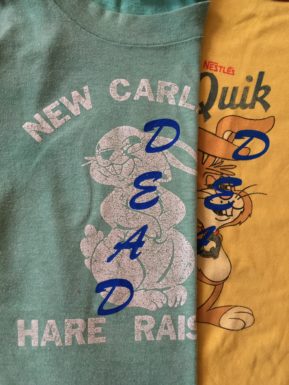
Courtesy of Ian Solaski.
IS: I wanted to incorporate as many aspects of Joseph Beuys's life into the collection while still creating something that was new and felt like my own. I started this pillar foundation where his artworks and concepts, his materials and tools, and his personal style was the foundation from which this collection was crafted.
In this pop-up exhibition, I will be presenting the clothing I have produced, all of which is made by recycled garments and materials familiar to Beuys' practice such as felt. I have been constructing homeware referencing some of his sculptural works, as well as my interpretation of Beuys' vitrines as functional furniture. There will be loose recreations of some of Beuys's installations, including a film illustrating some of the parallels previously described, as well as a number of social interventions paying homage to the artist.
JO: How do you see BLESHÜE moving into the future? What would be the ideal form of this project and its mechanics?
IS: I see this collection as an introduction to a new way of looking at commerce in general. I'd like to expose the concepts of Joseph Beuys to a larger audience and give them the agency in choosing whether or not participate in this passage of knowledge. I think a lot of times products, of any kind, are marketed with a one-dimensional function, and I'd like to see a shift where it is up to the individual to decide the function of a product, and how they choose to interact with it.
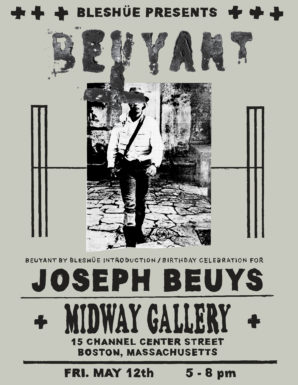
BEUYANT by BLESHÜE Introduction & Joseph Beuys Birthday Celebration, May 12th, 5 - 8 PM, Midway Gallery (15 Channel Center Street, Boston, MA). Follow BLESHÜE on facebook and Instagram

